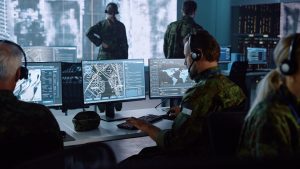Key Takeaways:
- Optics, especially in food delivery robots, enable autonomous navigation and precise task execution.
- Advancements in robotics have boosted the use of courier robots to address labor shortages and fulfill delivery needs.
- Integration of optical systems equips these robots with enhanced perception, overcoming labor challenges and improving delivery efficiency.
Optical Innovations Revolutionize Delivery Robots
In recent years, we’ve witnessed a notable rise in the deployment of courier robots. These robots have been introduced as a solution to address labor shortages, soaring wage costs, and the growing demand for swift package deliveries.
Optics play a pivotal role in the realm of robotics, particularly in the development of automated systems aimed at reducing the reliance on human intervention. One striking example of this is the emergence of food delivery robots, which employ a diverse range of optical instruments to adeptly collect visual data, understand their surroundings, and perform complex tasks. What follows is an exploration of some of these optical tools commonly employed in the world of delivery robots.
The crux of delivery robot technology lies in the amalgamation of various advanced systems and components that grant these robots the ability to operate autonomously and execute their delivery missions with precision. Among the key technologies that underpin delivery robots are:
Key Technologies of Delivery Robots:
Navigation and Localization: Ensuring accurate navigation is paramount for delivery robots. They utilize cutting-edge technologies like GPS (Global Positioning System), SLAM (Simultaneous Localization and Mapping), LIDAR (Light Detection and Ranging), and computer vision to map their surroundings, chart optimal routes, and pinpoint their exact locations in real-time.
Obstacle Detection and Avoidance: To ensure safe and efficient navigation, delivery robots must be equipped to detect and circumvent obstacles in their path. Sensors such as cameras, ultrasonic devices, and LIDAR systems enable them to identify obstacles and devise alternative routes.

To implement these significant technologies, a myriad of components and assemblies are integrated into the robots:
- Precision Camera Technology: At the core of visual perception lies the camera, an essential optical tool for data acquisition. Cameras serve as the robotic “eyes,” proficiently capturing intricate imagery of their surroundings, generating both images and videos. These visuals are indispensable for crucial tasks such as identifying obstacles, categorizing objects, and pinpointing locations. The camera lens takes on the pivotal role of capturing incident light onto the optical sensor. Employing advanced optical designs, including aspherical and multifocal aspherical lenses, these robots mitigate optical distortion and ensure the production of high-quality images.
- Three-Dimensional Vision: Incorporating 3D cameras into the robotic sensor suite enables the acquisition of stereoscopic imagery and depth data. These cameras are often equipped with Structured Light or Time-of-Flight technology, complemented by specialized optical elements like aspheric lenses. The harmonious interplay of these components ensures the generation of exceedingly precise depth information. Consequently, these optical systems enable robots to discern object dimensions, profiles, and execute nimble grasping and manipulation.
- Image Sensor Efficacy: The transformation of captured light into digital imagery is facilitated through image sensors, converting photons into electrical signals. Within the domain of food delivery robots, two prominent sensor types prevail: CMOS (Complementary Metal-Oxide-Semiconductor) and CCD (Charge-Coupled Device). These sensor varieties are favored for their compatibility with the intricate tasks demanded of food delivery robots.
- Selective Filtering: Filters, equipped with the capability to selectively transmit or block light within specific wavelength ranges, play a pivotal role. For instance, infrared filters are integral to infrared cameras, enabling the capture of infrared data while effectively filtering out visible light.
- Beam Splitting Proficiency: Beamsplitters emerge as strategic optical components tasked with dividing incoming light into multiple trajectories, facilitating the simultaneous acquisition of multiple images. This multifaceted optical strategy augments the perceptual acumen of robots, enabling them to process visual data with heightened efficiency.
In summary, these optical systems constitute indispensable facets of the robotic toolkit, equipping food delivery robots with the ability to comprehensively perceive their surroundings and execute tasks with utmost precision. Enhanced by the integration of cutting-edge artificial intelligence, image processing algorithms, and machine learning methodologies, these optical marvels empower robots to extract and harness information for object recognition and manipulation. In doing so, they fortify the autonomy and operational proficiency of these robots, effectively addressing the challenges posed by a shortage of human labor resources.
GREAT ARTICLE!
Share this article to gain insights from your connections!







